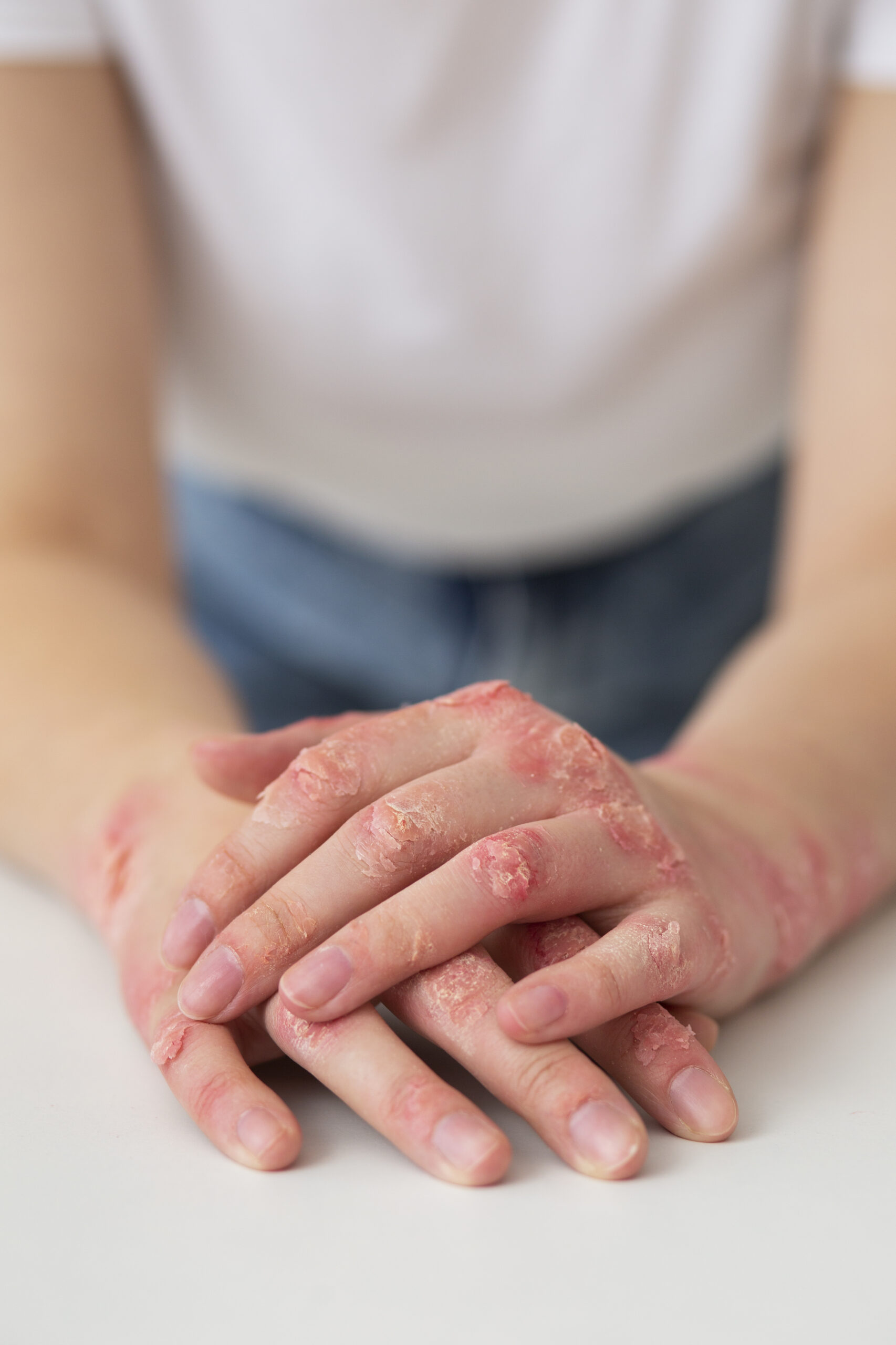Skin Disorders
Home
Skin Disorders
Ayurvedic Treatment for Skin Diseases | Natural Skin Healing
Skin conditions like psoriasis, eczema, acne, and rashes can affect both health and confidence. Modern medicine often suppresses symptoms, but the Ayurvedic Treatment for Skin Diseases The Natural Skin Healing approach goes deeper by correcting root causes. Through dosha balance, detoxification, and herbs, Ayurveda ensures natural skin healing and long-term relief.
Causes of Skin Diseases in Ayurveda
The Ayurvedic Treatment for Skin Diseases | Natural Skin Healing method identifies multiple root causes:
Genetic Predisposition
Family history increases the risk of chronic skin disorders.
Immune System Dysfunction
Overactive immunity leads to inflammation and rapid skin cell turnover.
Poor Digestion & Toxin Buildup (Ama)
Toxins enter the blood and accumulate in skin tissues.
Unhealthy Diet
Oily, fried, and processed foods aggravate Pitta dosha and trigger breakouts.
Stress and Lifestyle Factors
Stress, poor sleep, and sedentary habits worsen flare-ups.
Environmental Triggers
Pollution, infections, and chemicals can irritate skin.

Stages of Skin Diseases in Ayurveda
Ayurveda classifies skin diseases into progressive stages. The Ayurvedic Treatment for Skin Diseases | Natural Skin Healing approach offers remedies for each stage.
Stage 1 – Mild
Small patches, redness, or itching appear.
Stage 2 – Moderate
Scaling, dryness, and discomfort spread to larger areas.
Stage 3 – Severe
Inflammation, pain, and thick skin plaques develop.
Stage 4 – Chronic / Resistant
Persistent or recurring skin disease requiring long-term Ayurvedic therapies.
Common Skin Diseases Treated with Ayurveda
The Ayurvedic Treatment for Skin Diseases | Natural Skin Healing method works effectively for:
Psoriasis (Ekakushtha)
Thick, scaly patches caused by Pitta–Kapha imbalance.
Eczema (Vicharchika)
Dry, itchy, and inflamed skin due to Kapha and Pitta aggravation.
Acne (Yauvan Pidika)
Excess oil secretion and blood impurities lead to pimples.
Fungal & Bacterial Infections
Neem and turmeric offer natural antimicrobial effects.
Ayurvedic Approach to Natural Skin Healing
The Ayurvedic Treatment for Skin Diseases | Natural Skin Healing strategy combines therapies, herbs, and lifestyle practices:
Detoxification (Shodhana)
Panchakarma Therapies
- Virechana (purgation) clears toxins
- Raktamokshana (blood purification) cleanses skin
- Abhyanga (herbal oil massage) soothes irritation
Herbal Remedies (Shamana)
Neem, Manjistha, Aloe Vera, Turmeric, and Guduchi purify blood and restore balance.
Diet & Lifestyle Guidance
- Fiber-rich meals, seasonal fruits, and warm water
- Avoid fried or incompatible food combinations
- Yoga, pranayama, and meditation to reduce stress
Benefits of Ayurvedic Treatment for Skin Diseases Natural Skin Healing
- Treats the root cause, not just visible symptoms
- Reduces itching, redness, and scaling naturally
- Strengthens immunity to prevent recurrence
- Restores clear, glowing skin without side effects
FAQ
While modern medicine often suppresses symptoms with steroids or antibiotics, Ayurveda targets the root cause through dosha balance, detoxification (Shodhana), and immune support. It offers gentle, long-term healing without harsh side effects.
Ayurveda attributes skin disorders to:
- Imbalanced doshas (especially Pitta and Kapha)
- Ama (toxins) in the blood due to poor digestion
- Stress, poor lifestyle, and wrong food combinations
- Environmental factors like pollution or allergens
The Ayurvedic Treatment for Skin Diseases | Natural Skin Healing is effective for:
- Psoriasis (Ekakushtha)
- Eczema (Vicharchika)
- Acne (Yauvan Pidika)
- Fungal and bacterial infections
- Urticaria, rashes, and allergic dermatitis
Common herbs used include:
- Neem – blood purifier and antibacterial
- Manjistha – improves complexion and heals inflammation
- Guduchi – immune-boosting and anti-inflammatory
- Turmeric – reduces redness and itching
- Aloe Vera – soothes and moisturizes irritated skin
Panchakarma is a detox therapy in Ayurveda that helps eliminate deep-seated toxins (Ama) from the body. For skin conditions, Virechana (purgation), Raktamokshana (bloodletting), and Abhyanga (herbal oil massage) are often used to purify blood, calm doshas, and clear skin.
Initial improvements such as reduced itching or redness may appear in 2–4 weeks. However, chronic or severe cases may require 3–6 months of consistent herbal therapy, Panchakarma, and lifestyle changes for lasting relief.
Yes. Ayurvedic remedies are typically natural, gentle, and free from steroids or harsh chemicals, making them safe for all ages, including children and people with sensitive skin. Always consult a qualified Ayurvedic practitioner for proper guidance.
Ayurveda focuses on long-term management and prevention by treating the root cause. Many patients experience complete or significant relief with continued treatment and adherence to Ayurvedic lifestyle and diet practices.
- Eat light, easily digestible meals with seasonal fruits and vegetables
- Avoid spicy, fried, fermented, and incompatible foods (e.g., fish with milk)
- Drink warm water and herbal teas to support detoxification
- Avoid cold or stale foods that aggravate Pitta and Kapha
To maintain healthy skin:
- Follow a Pitta-Kapha pacifying diet
- Practice stress-reducing routines like yoga and pranayama
- Avoid skin irritants like harsh soaps and pollutants
- Perform seasonal Ayurvedic detox therapies (Panchakarma)
- Use herbal oils or ubtan (herbal paste) for regular skin care
